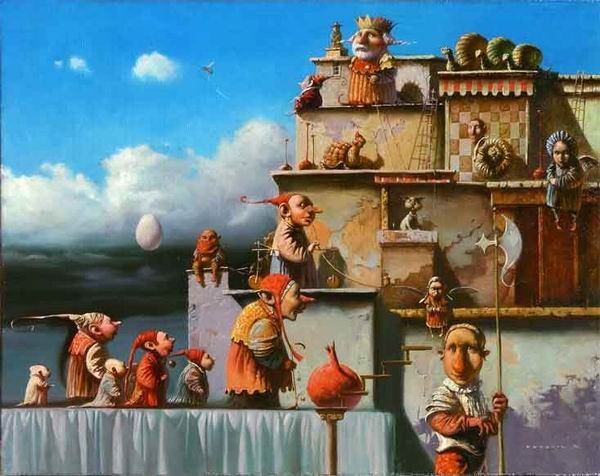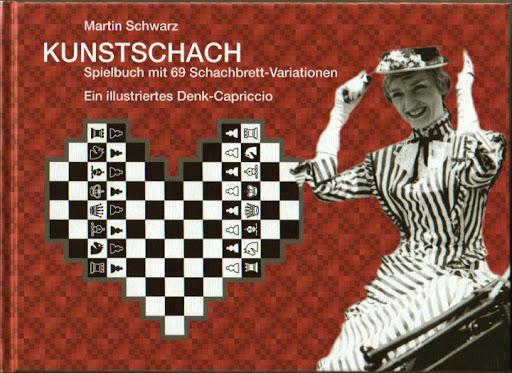
Swiss Chess Potpourri
I dedicate this blog to three people, @Knez1013, @Simaginfan and @MarcelGottofrey. @Knez1013 made me get excited for the idea, and @Simaginfan and @MarcelGottofrey contributed to it.
.
Switzerland is not a big chess nation, unlike Russia, the US, England, or Germany. Nevertheless, the game has a long tradition there.
Chess Society Zürich
Schachgesellschaft Zürich (SG Zurich) founded in 1809, is the oldest surviving chess club in the world.
SG Zurich made a significant contribution to the popularization of the game and development of the chess organization in Switzerland. The club has organized major international chess tournaments, and is still one of the leading chess clubs in the country.
SG Zurich played the first documented team match against the Schachgesselschaft Winterthur in 1822.
In 1840, the club member Conrad von Orelli published "Chess Booklet", a "vivid illustration of the rules of chess and the most meaningful moves of famous players for beginners."
In 1888 and 1898, the German master Emil Schallopp and world chess champion Emanuel Lasker played simuls in Zurich.
In 1925, 1928 and 1931 Alexander Alekhine, Efim Bogolyubov and Aaron Nimzowitsch visited the Club SG Zurich.
On the occasion of its 125th anniversary in 1934, the Club held an international tournament for the first time in the history of Swiss chess. Alexander Alekhine won ahead of Max Euwe and Salo Flohr.
The absolute highlight of the Club's history was the organization, in 1953, of the Candidates Tournament for the 1954 World Chess Championship. The SG Zurich with its tournament director Alois Nagler had been given a large part by the Swiss Chess Association (Schweizerische Schachverband, SSV) in organization of the tournament. David Bronstein wrote a book about the tournament that is one of the classics in chess literature.
Swiss System
It is a tournament format, i.e. a method of pairing, so called because it originated in Switzerland: the first person to suggest the system appears to have been a Swiss citizen named Dr Julius Müller, and the first chess tournament run under this system took place in Zürich in 1895. The Swiss Paring method addresses significant problems of round robin and single elimination tournaments with a high number of players.
Paintings
1. Matthaeus Merian the Younger (1621 - 1687) The Kaiser Valentinian Plays Chess, 1657

2. Jean Paul Hubert (1732 - 1803)
Voltaire at a Chess Table, btw 1750 and 1775
State Hermitage Museum, Saint Petersburg


4. Karl Aegerter (1888 – 1969) Die Schachspieler 1930

5. Paul Klee (1879 - 1940) Chess, 1931

6. Paul Klee, The Red and the Black
As @SearleAdrian on Twitter put it, Klee's paintings jiggle and sing ... KEEPS ON HAPPENING AS YOU LOOK

7. Paul Klee, Stadtburg Kr. (Town Castle Kr.), 1932
Remember, it keeps on happening as you look!....

8. Jean Arp (German, 1888-1966) & Sophie Taeuber-Arp (Swiss, 1889-1943)
Untitled (Duo-collage), 1918; paper, board, silver leaf on board
Sophie was a Dada artist & modern dancer; performed at the Cabaret Voltaire, a central meeting place of the Dadaists. Her husband Jean was a sculptor, painter & poet. They collaborated on numerous joint projects until her death in 1943 (despite being overlooked since her death, Sophie is considered one of the most important artists of concrete art and geometric abstraction of the 20th century).

9. Isabelle Hoffer, La Nave è partenza

Sculpture
1. Isabelle Waldberg (French-Swiss, 1911-1990)

Portrait of Marcel Duchamp on an old Chinese chessboard with 2 pieces and 2 sculptures ca. 1978; portrait Duchamp 1958. 5 objects made of bronze, marble, iron, wood, painted and aluminium on an old wooden chessboard, lacquered
(Berne Art Museum)
.
2. Méret Elisabeth Oppenheim (1913, Germany - 1985)
Bon Appétit, Marcel! (La Reine Blanche), 1966-1978. Homage to Marcel Duchamp
mixed media: chess queen in bread dough lying on a framed white plate with a fork and a knife, all placed on a chessboard, with a glass in the upper left corner

.
3. Jürg Hassler (1938, Zurich) is a Swiss photographer, sculptor, screenwriter, film director, cameraman and film editor.
"He constructs chessboards and chessmen, reinventing the old game of chess, giving it back the ludic component that he finds missing in today’s chess. He puts the accent on the game and the pleasure of playing, without any obligation to have to prove anything, without any obligation to have to win, but rather to invent ever new shapes of dialectical contrasts, with a decided preference given to shape over color.
"Movement – a crucial factor for Hassler from his filmmaking period – is integrated in his works in the form of chess rules that result in plastic, sculptural modifications.
"Despite certain new aspects, the basic features of the game remain the same as those of past centuries: a network of coordinates to enable strategic moves of the figures: foot soldiers, combat elephants, messengers, knights – a game with endless possibilities.
"Hassler shapes the chessboard as a terrain with one hill, with two hills, with a river. He soon abandons the strict color differentiations in favor of other formal distinctions, so that, at the end, the network of coordinates disappears completely from the game board.
"The search for confusion grows more and more, though one must be able to play each game. Time is of no consequence. In more recent works, the players are increasingly encouraged to shape the terrain in common and, during the game, to place the figures on their squares so as to achieve a “beautiful” order; thus, depending to one’s understanding of the game and its rules, a chaotic hazard ensues in the formal constellation that may be corrected by the players along aesthetic lines within the relatively narrow context of the game.
"The interest lies in the constant exchange between apparent chaos and order, between form and lack of form, and a different, slightly sidelong glance, affords a new way of seeing.
"This multi dimensional surpassing of the imaginative powers in order to shape modifiable chess pieces into a landscape or an architectonic composition requires flexibility and a fresh conceptual approach. It further adds to the pleasure of the game, which is Jürg Hassler’s real aim: to free chess from its restrictive and rigid conventions."
Mattomatt: Chess Pieces, 2007
oak, iron, bones, hemp cord, H: 40 cm; 270 x 300 cm (Museum Tinguely, Basel)

4. Mattomatt
Here is another chessboard and pieces invented by Jürg Hassler
Mecca, 2005
Stone slab (Shiva black), wooden frame, figures, 100 x 80 cm (Museum Tinguely, Basel)

.
Chess sets
Alberto Giacometti (1901 - 1966) was a Swiss sculptor, painter, draftsman and print maker.
Chess set, 1946-1947, glazed terracotta; King's size 13.7 cm (5 3/8 in.), pawn's 7.6 cm (2 7.8 in.)
The set has been sold for £50,000 at the Phillips auction.
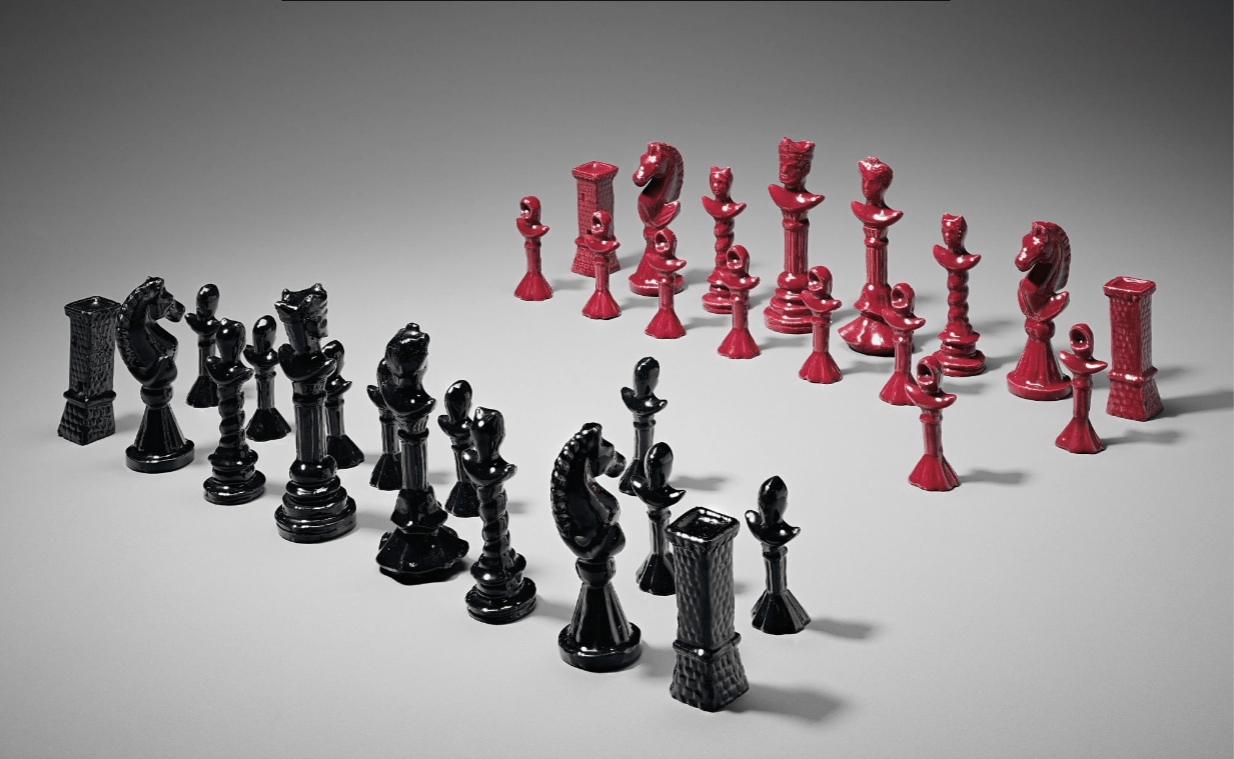
.
Marcel Duchamp's Pocket Chess Set, 1944 (The Art Institute of Chicago)

Chess Magazine
The Schweizerische Schachzeitung was published for the first time in 1857 by Friedrich Capräz, one of the first chess pioneers in Switzerland. It had a concentration on international news and on chess problems.
Below is the 2/2000 edition (.pdf version).
You can find all Revue Suisse des Echecs since 2000 if you go to this link.
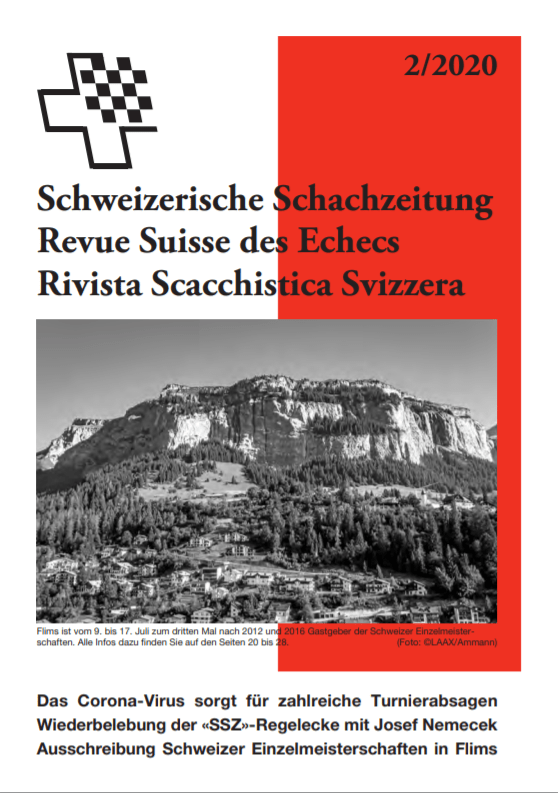
.
Chess Variations
Martin Schwarz is a graphic artist, lithographer from Winterthur. He published Kunstschach, a book with 69 chess variants.

Here are two variants, Umweg (Detour) and Einsamkeit (Intimacy)


.
Youth chess
An ancient game defies the mobile phone and the digital world: chess is becoming increasingly popular with children and adolescents - even those who otherwise hardly sit still. This also appeals to parents, because it allegedly promotes cognitive skills.
The trend towards playing chess in children and adolescents started more than twenty years ago. Since then, various new private schools have emerged: In addition to Hug's “Schulschachprofis ” with over 500 young members (Werner Hug is a Swiss chess player. the World Junior champion in 1971 and Switzerland's leading player of the 1970s.), there are Chess4kids , Chessmates and the chess school Markus Regez. And the number of players under the age of 16 who are registered with the Swiss Chess Federation has doubled to around 1,000 since the turn of the millennium.

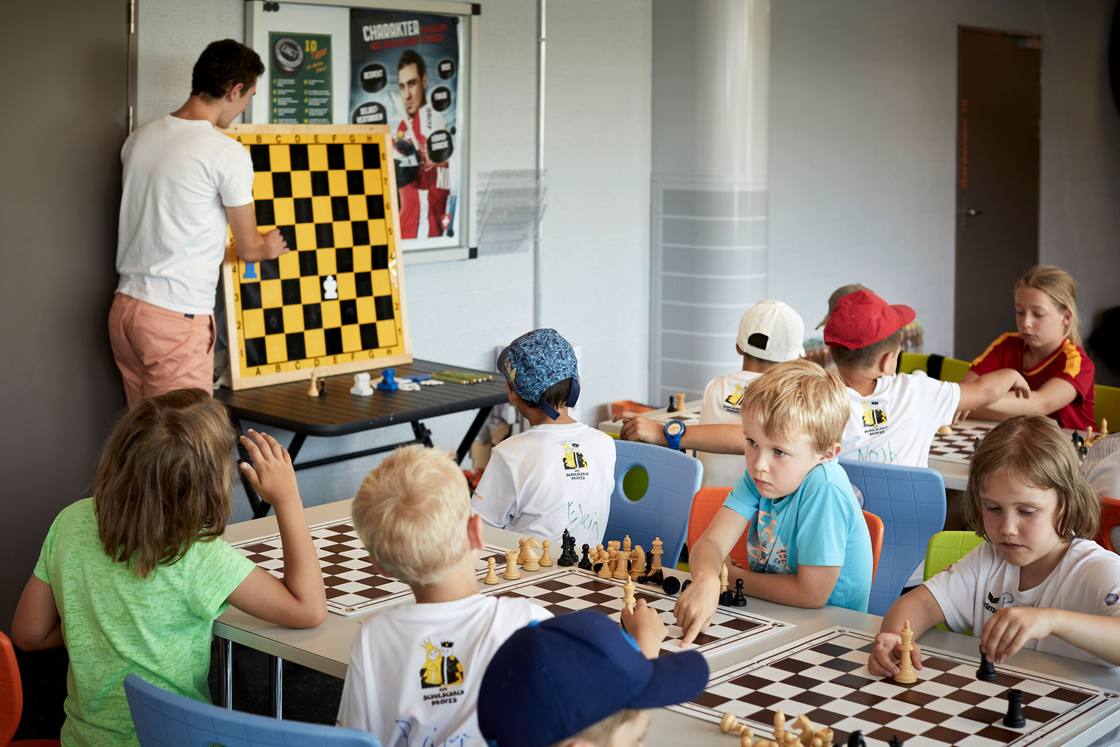
.
Street chess game with large board and chessmen is very popular in Switzerland.
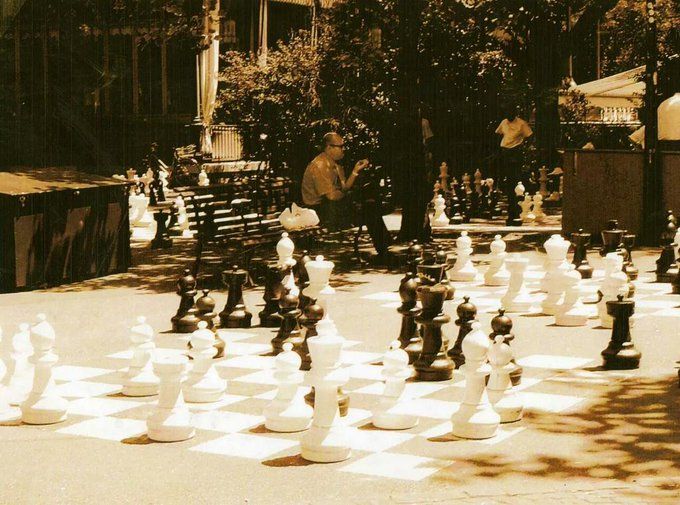
.
In the following photo you see two men playing chess at a Swiss Food Charity Center.
Visitors receive warm drinks, soup and fruit throughout the day, and also games to pass the time (interestingly, they're allowed to bring their own alcoholic beverages).
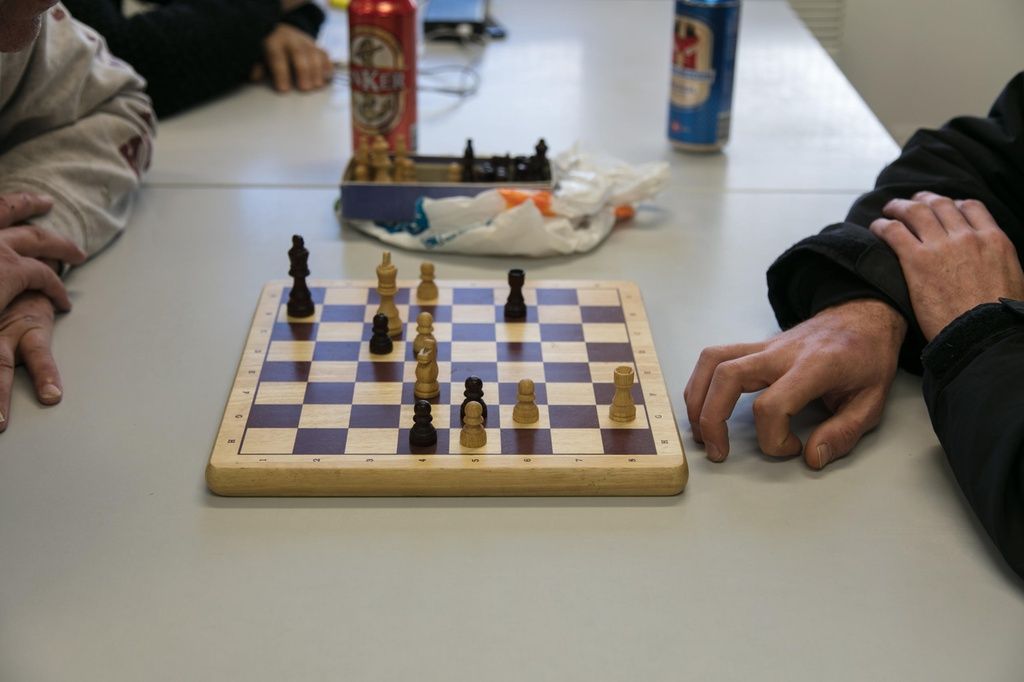
.
Street art/Graffiti
Street art of Estavayer-le-Lac (a Swiss municipality of the canton of Fribourg, situated on the south shore of Lake Neuchâtel)

.
Chess Players
Here is the list of most prominent Swiss players of the 20th century.

I picked three of them to present to you in this blog post, Hans Fahrni, Hans Johner and Henri Grob.
.
Hans Fahrni
Hans Fahrni (1874, Prague – 1939, Ostermundigen) was a Swiss chess master.
In 1909, Fahrni won, ahead of Savielly Tartakower, Semyon Alapin and Rudolf Spielmann, in Munich (Quadrangular).
He was the first master to play 100 opponents in a simul at Munich in 1911.
His finest achievement came in 1911 at San Remo where he finished 1st, ahead of Levitsky, Przepiorka, Gunsberg, Kostic, Forgacs and Reti. He was awarded the prize money of 2500 Francs and the 100 Francs brilliancy prize for his game against von Scheve.

.


Here is a chess problem composed by Fahrni
 In 1922, he was the first to write a chess monograph on 1.e4 Nf6. He dedicated it to Alekhine ("einführe die ich ihm hiermit freundlichest widme! "). By the way, in 1908, he drew with Alekhine (+1 –1 =1) in a Munich match.
In 1922, he was the first to write a chess monograph on 1.e4 Nf6. He dedicated it to Alekhine ("einführe die ich ihm hiermit freundlichest widme! "). By the way, in 1908, he drew with Alekhine (+1 –1 =1) in a Munich match.

.
Hans Johner
The brothers Paul Johner (1887-1938) and Hans Johner (1889 -1975) of an old Basel family are among the most striking figures in Swiss chess history.
Hans was a musician by profession, a violinist, and a chess player; along with his brother Paul the strongest Master of the first half of the 20th century.
He grew up in Bern and Frankfurt, in a family with nine children. Since childhood, he played chess with his brother. He received a musical education as a violinist and viola player and played for more than forty years in the Tonhalle Orchestra. He had taught at the Zurich Conservatory for 52 years.

He gained his master-title at the German Federation Tournament at Hamburg in 1910. International Master (1950), problemist. 12-time Swiss champion (1908 - 1950); became a bronze medalist at the National Championship at the age of 70.
The author of about 300 problems. His problems are of strategical kind, distinguished by great depth and subtlety. From 1914 to 1971 he was the chess columnist for the Neue Zürcher Zeitung newspaper.
Hans Johner played in Scheveningen 1923
Paul Johner remained the only undefeated player, scoring 8.5/10. He was individual best alongside with Rudolf Spielmann, ahead of Richard Réti, Géza Maróczy, Jacques Mieses, Edgar Colle, Frederick Yates, and young Max Euwe.
In the co-called Scheveningen system two teams are build. Subsequently, every player from the first team plays against every player of the second team (i.e. Foreigners versus The Netherlands in Scheveningen 1923; 10 players each team).

.
1924 Berlin (Quadrangular): Paul Johner the winner (ahead of Rubinstein, Teichmann, and Mieses)

Here is a beautiful friendly game played between the two Johner brothers, and a chess problem by Hans.
Check the lovely study-like last move after which Black immediately resigned!
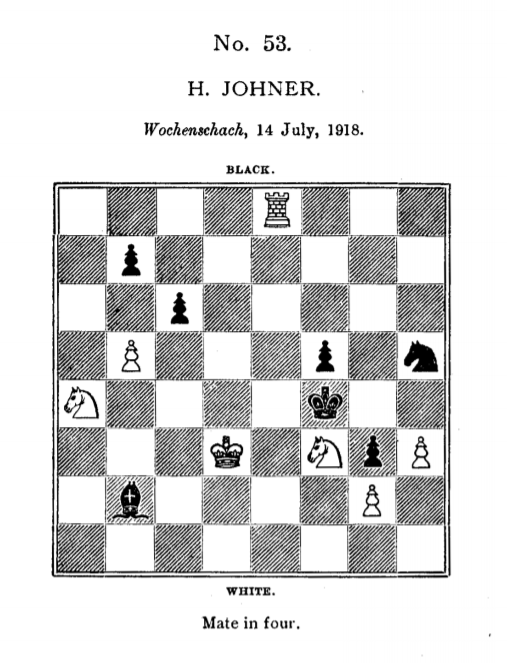
As a bonus, I give you two collections of chess studies/problems by Swiss composers:
Alpine Chess 1848 - 1921 by Moriz Henneberger / G. Hume / Alain C. White
Works of art on 64 fields 1922 - 1966 by Hans Ott / Konrad Kummer / Hans Jakob Schudel
.
Henri Grob
Chess would never have come to life in Switzerland, if not for two people: Henri Grob and Victor Korchnoi.
Henri Grob (1904-1974) comes from an old Swiss stock. He was born in 1904, at Broumov (Ger. Braunau, Czechoclovakia) to which town his parents had emigrated. A chess master, artist and painter (artistically captured Thomas Mann, Le Corbusier and many other celebrities on paper; an anthology was published in 1965 under the title «Henry Grob, The Draftsman and Painter»). His performances on the European scene of the 30s significantly increased the popularity of the black and white game in the country of banks and chocolate.
As a 17yo he beat Alekhine in a simul. Awarded the IM title in 1950. However, Grob did not become a pro. In everyday life, the master was engaged in journalism and painting - this brought more income than chess competitions.
Grob married nine times. When once asked if he were married he replied "Fast immer" ("Almost always.")
He pioneered the eccentric 1.g4, known as Grob's Attack.
Grob played in Meran (or Merano) 1926, a town in South Tyrol, Northern Italy, with a mild climate and palm trees growing. A glance at the names of the contestants (see the pic below) will show how many are involved in opening theory: the Colle System, the Grunfeld Defense, Grob’s Angriff. Of course, there is also the Meran Variation in the Semi-Slav.
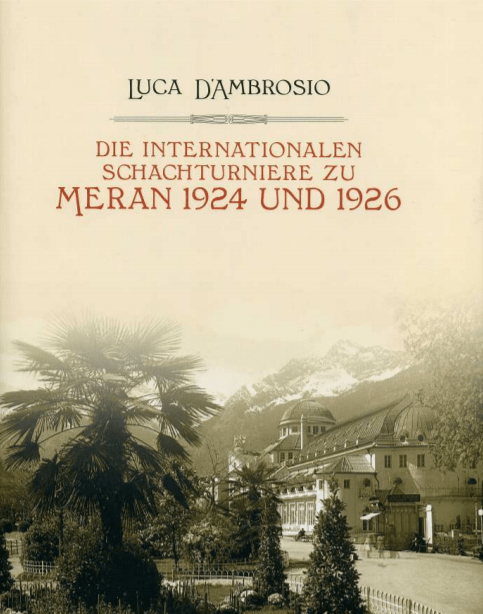

.
Here is a game from the tournament (my big thanks goes to @simaginfan on whose suggestion the game is here)
.
The finest hour of Grob came at the 1937 Ostend, when he sensationally shared the first prize with Paul Keres andReuben Fine, defeating both in their individual games! At the time, Keres and Fine were considered to be two of the hottest contenders for the World Cup, a claim that they confirmed with a double victory in the famous AVRO 1938 ahead of Botwinnik, Euwe, Reshevsky, Alechine, Capablanca and Flohr.
.

 Ostend 1937 Left to right R. Fine, H. Grob, G. Koltanowski, P. Keres, A. Dunkelblum, S. Landau, S. Tartakower, A. Reynolds, I. Dyner, P. List
Ostend 1937 Left to right R. Fine, H. Grob, G. Koltanowski, P. Keres, A. Dunkelblum, S. Landau, S. Tartakower, A. Reynolds, I. Dyner, P. List
.
Here's a photo from the Zurich 1951 match Grob played Chantal de Silans, the French WIM, and a sketch of Grob's opponent.


Suisse at Olympiads
At the first chess Olympiad in London 1927, Switzerland (Hans Johner, Oscar Naegeli, Henri Grob, Otto Zimmermann, Walter Michel) came in eighth ahead of the Kingdom of Serbs, Croats and Slovenes, the country I was born in (Kostic, V. Vukovic, Asztalos, Kalabar), Italy, Argentina, France, Spain... (again big thanks to @simaginfan for providing the info and the pic on the Swiss participation at the Olympiad)

Walther - Fischer game
Thanks to @MarcelGottofrey and his remark on Twitter, here is a story of Edgar Walther (1930 - 2013) a FIDE Master and International Correspondence Chess Master (ICM, 1978); also the Swiss champion in blitz.
He is best known for his game at Zurich 1959 with the future World Chess Champion Fischer, in which the 16-yo Bobby narrowly missed a loss. In 1969, Fischer included the game in his My 60 Memorable Games.
.

Edgar Walther and Bobby Fischer during the game; Tal, the winner of Zurich 1959 is looking on
.
.
Solution to the H. Johner's problem:
1.Rh8 Bxh8 2.Nc5 Ng7 3.b6
This problem represents the Seeberger idea. The key-move forces a critical move of the Black Bishop into a corner square, where it is intercepted and shut in by the Black Knight, thus forcing a block position.
.
More Potpourri and Chess Art:
3. Chess Art by Cheval (my most viewed post ever, 7435 views so far)


